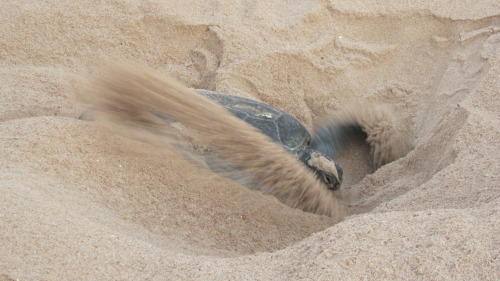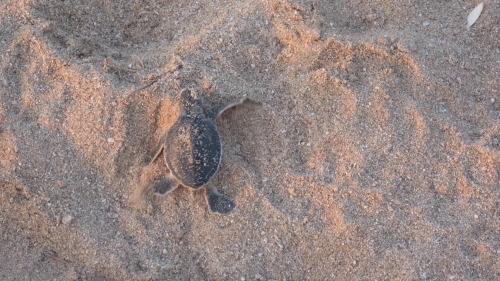The Green Turtles of Ras Al Jinz
 Monday, October 10, 2011 at 3:00PM
Monday, October 10, 2011 at 3:00PM Situated on the coast of Oman, at the eastern most tip of the Arabian peninsula, is a remote spot called Ras Al Jinz. With nothing more than a tiny ecotourist resort at a reasonable distance from its beaches, Ras Al Jinz is one of the birthplaces of the endangered Green Sea Turtle.
Every year, about 10 000 awe inspiring female green turtles come onto these beaches to nest. They do this three times in one season with a two week interval between each return. This results in approximately 30 000 nests being built on these beaches each year.
After the nesting season is over, the female turtle, who can weigh up to 150kg, swims away to far away oceans for three years, only to return again in the fourth year when the whole process repeats itself. The males frequent the breeding grounds but never leave the ocean.
Studies of their migration patterns reveal that these turtles, once exploited without restriction but now globally protected, cover most of the world on their travels. Some travel up to 65 000 km in a lifetime which normally lasts for about 80 years.
This past weekend, I was privileged to witness the nesting and hatching process. After a journey by car which lasted almost nine and a half hours, we arrived weary but excited at the resort. Tours to the beach were offered at 04h00 and 21h00 each day.
On the evening tour, the moon played the role of our tour guide’s assistant and helped to light the way, but in the early morning we held onto each other at times as we quietly approached the nests on the beach in torchlight and at times in pitch darkness. The milky way sparkled above us, a reminder of how far away we were from light pollution of any kind.
The female turtle digs out a nest 1/4 metre deep. Within this she digs another smaller hole also 1/4 metre deep, into which she lays approximately 100 eggs, golf ball like in size. Using her back flippers she slowly covers these eggs with sand, compressing it as she proceeds. Using her front flippers she then scoops up sand and scatters it behind her, leaving a camouflage nest by the time she heaves herself onto the flat of the beach and slowly makes her way back to the ocean.
The eggs remain under the sand for 55 days, the temperature of the sand determining the sex of the hatchling. After it hatches, the baby turtle instinctively begins its journey into the ocean, its tiny flippers spinning like propellers. This is no easy task as predators such as foxes and seagulls have to be avoided. Inland lights, if there, can lure the baby in the wrong direction. Once in the sea, the baby turtles are often eaten by fish or caught in nets. There is no parental care. Only 1 in every 1000 babies makes it to maturity.
Most amazing is the fact that once the female turtle reaches maturity she returns to lay her eggs on the very beach on which she was born!
Ras Al Jinz is a special place.
Despite the fact that sea turtles spend almost all of their lives submerged, they must breathe air to obtain the oxygen required for the demands of different activities. The breath is very important to the sea turtle. I too, wish to pay more attention to mine.
The speed of everyday physical and virtual life exists. There is however, also a need for periods of slow pace. Each has its time and place.
I am not yet able to fully verbalize what I was privileged to experience. I am reminded, however, that the shadows of my being are often poorly lit and that I need others on my life’s journey. Hiding in these shadows are mysteries and scenes of creativity. Some occur unattended, but every now and again awareness allows us to participate fully.
The hatchlings of my experiences are precious.
What I saw requires time to fully impact me. There is no haste. I am in no hurry; neither was she. Each step had its moment for those who cared to see.


